Anodontia, the hereditary absence of primary or permanent teeth, is present in approximately 2% of the population and most commonly affects maxillary lateral incisors.1 Congenitally missing maxillary lateral incisors have been a challenge confronting dentists for a long time. While there are differing treatment modalities for maintaining, preserving, and treating patients, one thing is certainly agreed upon: Treatment must be conservative in nature.
Dentists have made great strides in how we manage these cases, overcoming both the physical malformations and the impact of patient self-consciousness. We can now achieve clinically pleasing smiles and alignment of teeth while boosting patient confidence. Treatment planning needs to take into account the physiology, social maturity, and emotional intelligence of each patient. This is of particular importance in the early stages of treatment.
Although there are many options for treating or preserving the space created by lateral incisors, the most common types will be discussed.
Currently, there are 5 mainstream treatments for missing maxillary lateral incisors:
- A clear aligner as a framework for a composite or plastic pontic.
Treatment Considerations: Aesthetically, these can work well while the aligner is in place, but many patients find them inconvenient due to functional limitations (eg, when dining out with friends or company, the aligner needs to be removed). For a highly impressionable and self-conscious adolescent, this may lead to a sense of social stigma and a struggle to hide his or her mouth while trying to eat and socialize—a true blow to his or her self-esteem and confidence. - A single-tooth retainer, typically a Hawley retainer with one or 2 pontics.
Treatment Considerations: Aesthetically, there is a wire showing, and for adolescents who have completed their orthodontic treatment, this can be another blow to a sensitive self-image or fragile self-confidence. As a removable appliance, it shares the same challenges as an aligner when dining with friends, etc. - A single-tooth, removable partial denture (AKA a stayplate or flipper)
Treatment Considerations: For adolescents and adults, the stigma of a “denture” can impact one’s self-image and self-confidence. The average human being’s conscious mind is very aware that these are fake teeth coming in and out of his or her mouth. Again, as a removable appliance, it shares some of the same challenges as an aligner or a retainer. - A Maryland bridge
Treatment Considerations: A Maryland bridge is a good aesthetic option; however, it may not be a very good long-term or conservative solution. This is a more invasive option due to the removal of some tooth structure (typically the lingual of at least one tooth, sometimes both proximal teeth). A Maryland bridge is more conservative than a 3-unit bridge, but it is still not a great treatment for healthy teeth as it is still invasive since we still have to remove tooth structure on a young child or a teenager. - A 3-unit fixed bridge
Treatment Considerations: A fixed bridge (fixed partial denture) should be the last option considered for these cases. Due to the extensive reduction of tooth structure, they are truly the least conservative form of treatment for a young patient. Our treatment focus should be as conservative as possible for all dentitions and especially for the adolescent.
A long-term goal for managing congenital anodontia has been perfecting less invasive options with aesthetically pleasing results that are sustainable until the patient is of an age where he or she can optimally have an implant.
When considering the range of restorative options following the completion of orthodontic treatment, the question becomes “What do we need to achieve for these patients restoratively until they are old enough for implants, and which treatment option will keep a single-tooth problem as a single-tooth problem and is most conservative?” This question led to the development of a strategy in our office, which we have used for some time, allowing us to use resin-impregnated, light-cured glass fiber strands to bond between 2 teeth. Once bonded, we create a pontic on the strand with composite. We etch and bond the fibers to the teeth, essentially without removing any tooth structure on the supporting teeth. The start is similar to techniques used for periodontal splints,2 while the finish can cause great joy in all its valued features for patients.
The glass fibers create a strong, stable backing to build composite on and provide a base for composite veneers to replace the missing teeth. This allows us to be extremely conservative and aesthetic while waiting for the patient to reach an age for implants. Throughout this treatment, the occlusion is kept light to almost entirely off the opposing teeth to sustain the restoration’s longevity.3 Repair, if ever needed, is simple and conservative. The patient is happy and confident. The procedure is a great conservative option that can eventually take them to the age for implants. Considering growth factors and individual factors, the optimal youngest age for implants is 18 to 25 years, depending on gender. If unsure of the growth phase, an evaluation of the epiphyseal plate (growth plate) can be done.4
CASE REPORT
A 13-year-old female presented with congenitally missing permanent lateral incisors after having completed orthodontic treatment (Figure 1). She was periodontally and occlusally stable. There were no restorations in her posterior teeth, and her anterior teeth were unrestored. She presented with no active decay, and her medical history was unremarkable. The patient had been diagnosed with congenitally missing maxillary lateral incisors, and her orthodontic treatment included creating ideal space for these teeth.
After a comprehensive examination, it was determined that there was no viable treatment for the retained maxillary primary lateral incisor other than removal and replacement as it was very loose. The patient’s parents were presented with a number of treatment options, from space maintenance to semi-permanent and permanent restorations. They chose to maintain the space until she is of age for dental implants. After discussing the different modalities of space maintenance, they chose the most aesthetic and conservative non-removable solution of bonded glass fiber with a composite veneer.
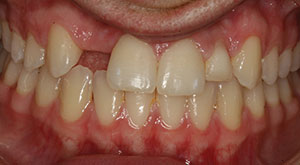 |
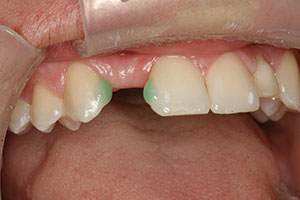 |
| Figure 1. The patient’s initial presentation, post orthodontic treatment. | Figure 2. The patient’s teeth Nos. 6 and 8 were etched in preparation for bonding. |
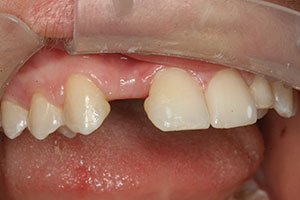 |
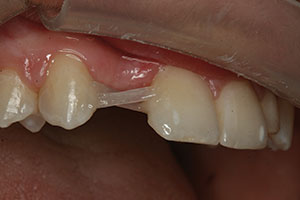 |
| Figure 3. A small amount of uncured flowable composite was placed on the surface of both teeth before the glass fiber was placed. | Figure 4. GrandTec glass fiber strands (VOCO America) were used to support the composite material that would create the pontic. |
 |
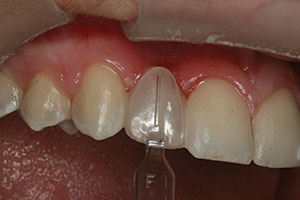 |
| Figure 5. The composite, Admira Fusion x-tra (VOCO America), was placed in 2-mm increments to begin formulating the missing incisor. | Figure 6. To create the ideal lateral shape, the Uveneer Extra template system (Ultradent Products) was used. |
 |
| Figure 7. The final restorations gave the patient a great alternative to standard post-op ortho treatment. |
Teeth No. 6 mesial and No. 8 distal were etched with 37% phosphoric acid (Uni-Etch w/ BAC Etchant [BISCO Dental Products]) for 15 seconds (Figure 2) after micro-roughening the surface using dental air abrasion with a microetcher (MicroEtcher II [Zest Dental Solutions]). Next, Futurabond U (VOCO America), a dual-cured universal adhesive, was used as the bonding agent to create an excellent bond between tooth and restoration. The bonding agent was light-cured using The Light (GC America), a cordless LED curing light. A small amount of flowable composite, GrandioSo Flow (VOCO America) (Figure 3) was applied to both surfaces of the teeth without curing in preparation for the glass fiber. The glass fiber used was GrandTEC (VOCO America), a glass strand pre-impregnated with light-curing methacrylate resin that remains pliable until its polymerization. This material does not require special gloves or scissors for use and, in this case, was placed in a crisscross fashion to help facilitate composite placement for the pontic (Figure 4). The glass fiber and the flowable composite were cured together for 20 seconds. Subsequently, the composite was now ready to be placed in 2-mm increments to begin shaping the missing lateral. VOCO’s Admira Fusion shade A2 (VOCO America) was used as a lingual layer to build the first steps of the lateral. VOCO’s Admira Fusion x-tra (VOCO America), a single-shade, omnichromatic, Nano-ORMOCER restorative, was used to formulate the remaining facial surface of the incisor (Figure 5). To give the ideal shape and produce a predictable and reproduceable composite restoration, the Uveneer Extra (Ultradent Products) template system was used (Figure 6). Once the composite was cured under the template, a process of adjusting and polishing the restorations commenced. Care was taken to ensure that there was access for the restoration to be flossed and that the occlusion was very light or completely off the restoration. The patient was given instructions not to use any shearing forces on the laterals, and the final restorations were photographed at the end of the procedure (Figure 7). The patient was extremely happy with the results of her restorations, especially because she now had non-removable, conservative treatment for her teeth.
CONCLUSION
This unique and non-invasive treatment for missing lateral incisors adds a conservative yet functional option to our armamentarium, giving patients another choice to bridge the gap between their smiles and confidence. While most of these cases are due to the congenital absence of maxillary lateral incisors, this glass-fiber-bonded temporary technique can be used as an interim treatment for adults as well. It can be used during the healing phases of implant treatment, during bone grafting procedures to prepare for implants, and during post-orthodontic cases for children and adults before missing teeth are replaced permanently. The technique can also be used to make a temporary for implants for patients who have had fixed or removable partial dentures to move forward into treatment while getting bone grafting and implants. This procedure, though conservative in nature, allows us, as dentists, not only to treat the physical needs of the patient but to handle the emotional and psychological sides as well.
References
- Fekonja A. Hypodontia in orthodontically treated children. Eur J Orthod. 2005;27(5):457–60. doi:10.1093/ejo/cji027
- Bhuvaneswari P, Gowri T, Ramkumar GD, et al. Periodontal splinting: A review before planning a splint. Int J Applied Dent Sci. 2019;5(4):315-319.
- Misch CE, Bidez MW. Occlusal considerations for implant supported prostheses: implant-protective occlusions. In: Misch CE, ed. Dental Implant Prosthetics. 3rd ed. Mosby Publishing Inc; 2005:472-510. doi:10.1016/B978-0-323-07845-0.00031-2
- Shillingburg HT, Hobo S, Whitsett LD, Jacobi R, et al. Chapter 7: Treatment planning for the replacement of missing teeth. In: Shillingburg HT, ed. Fundamentals of Fixed Prosthodontics. 3rd ed. Quintessence Publishing Co; 1997;120-121.
Dr. Halabo is a national and international speaker, author, and product evaluator. For more than 24 years, he has run a state-of-the-art private practice in San Diego. He is a graduate of the Boston University Henry M. Goldman School of Graduate Dentistry, and he completed a general practice residency at the Loma Linda, Calif, Veterans Hospital. He is an adjunct faculty member at the University of California, San Diego (UCSD), and has served as the director of dental care at the UCSD clinic in Pacific Beach, Calif. He has been involved in product evaluations for both the Catapult Group and Clinicians Report for many years and is proud and honored to share his knowledge and experience with those seeking to provide excellent dental care for their patients. Dr. Halabo lectures on a variety of restorative and surgical topics with an emphasis on improving patient care and dentists’ enjoyment of their profession. He combines technological and clinical advancements with the use of simple practice management tools to enhance the dental experience. He is a member of the San Diego County Dental Society, the California Dental Association, the ADA, the AGD, the Academy of Laser Dentistry, and the American Academy of Cosmetic Dentistry. He can be reached via email at sam@samhalabodmd.com.
Disclosure: Dr. Halabo reports no disclosures.
Related Articles
Predictable Class II Restorations Using Sectional Matrices
A Simple and Effective Treatment for White Spots
Are You Prepared for the Baby Boomers?


